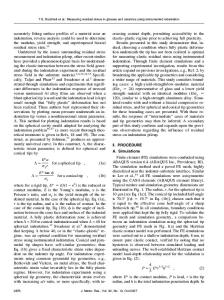Glasses and Ceramics from Colloids
- PDF / 480,103 Bytes
- 7 Pages / 414.72 x 648 pts Page_size
- 0 Downloads / 409 Views
GLASSES AND CERAMICS FROM COLLOIDS G. W. SCHERER,
R&D DIVISION,
Corning Glass Works,
Corning, NY 14831
ABSTRACT Flame-generated particles can be suspended in a nonpolar solvent, molded, and gelled. The microstructure obtained after solvent evaporation depends on the characteristics of the colloid. Higher solids loadings lead to denser green bodies and narrow pore size distributions. The mean Dore size is proportional to the particle size. Sintering occurs at relatively low temperatures, producing amorphous or crystalline bodies of high purity. INTRODUCTION This paper describes a process for making amorphous or crystalline ceramic bodies using particles made by flame oxidation, The particles are suspended in a nonaqueous, usually nonpolar, solvent, then molded and gelled. The characteristics of the colloidal dispersions and of the dried gels are discussed. Materials produced in this way include SiC2 , Ti0 2 , and A1 2 0 3 . PARTICLES Flame oxidation produces submicron oxide particles from reactions such as: SiCI TiCI 4AIC1 Si(CH3)b
3
4
+ 02
÷
Si0 2 + 2C1 2
(1)
4
+ 02
÷
Ti0 2 + 2C1
(2)
+ 302
+
2A1 2 0
+ 8 02 ÷
3
2
+ 6C1
(3)
2
Si0 2 + 4CO2 + 6H20
(4)
The reactants are passed through a gas/oxygen torch and the oxide products, formed in the flame, condense into droplets. This process is used to make optical waveguide fibers (1), because of the extraordinary purity of the particles. Flame oxidation is used commercially to make amorphous Si0 2 and crystalline A1 2 03 and Ti0 2 for use as fillers and pigments. The oxide particles (often called "soot") are typically 10-300nm in diameter. The size and size distribution can be controlled by adjustment of the concentration and residence time of the reactants in the flame [2]. A "narrow" distribution for this process would include diameters ranging over a factor of -4. The particles are believed to nucleate rapidly and grow by coalescence [3]. The particle diameters seen in electron micrographs agree with those found by nitrogen adsorption, indicating that the particles are nonporous. COLLOIDS It is to avoid:
convenient to disperse the soot in
a nonaqueous solvent in
order
OH contamination (important for optical silica); dissolution of certain oxides (e.g. P 2 0 5 ); high capillary stresses resulting from the high surface tension (y) of water. The low y of organic solvents (-20-30 ergs/cm2 vs 72 ergs/cm2 for H20) facilitates drying of gels without cracking. Agglomeration of the particles (1) (2) (3)
Mat.
Res. Soc. Synp. Proc. Vol.
32 (1984)
Published by Elsevier Science Publishing Co.,
Inc.
206
is prevented by adsorbing a steric barrier of chain-like molecules Qn their surfaces [4]. Interpenetration of the adsorbed layers exacts a penalty in enthalpy (to displace a layer of solvation around the adsorbed molecules and entropy (to restrict the motion of the chains) [51; it is not known which of these factors is dominant in these colloids. The closest approach of two particles is limited to about twice the thickness of the adsorbed layer. If,
Data Loading...











